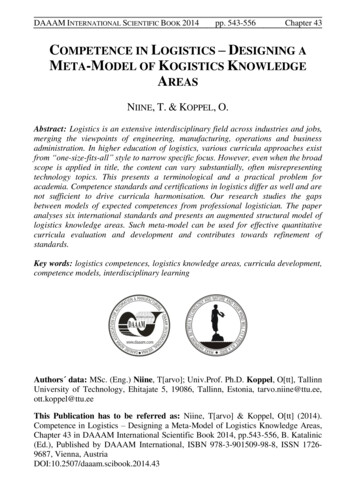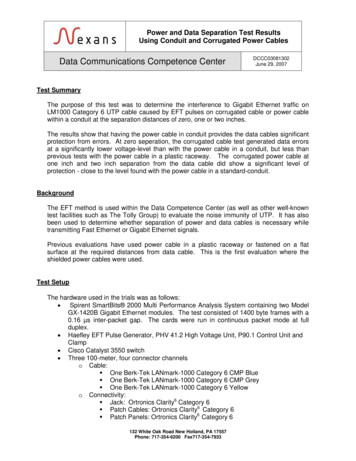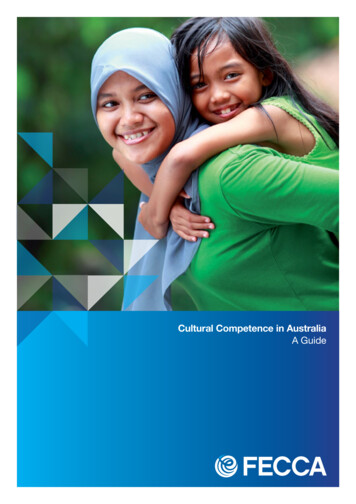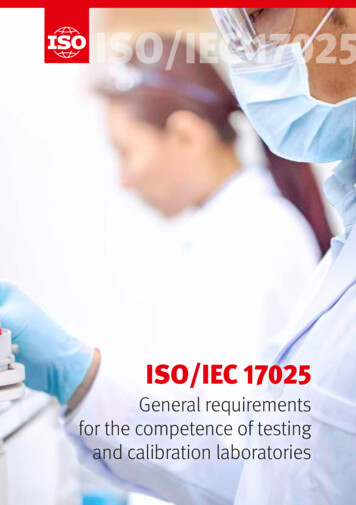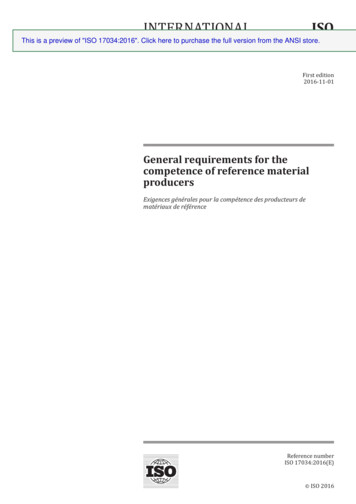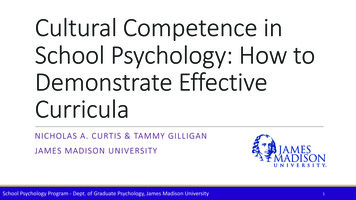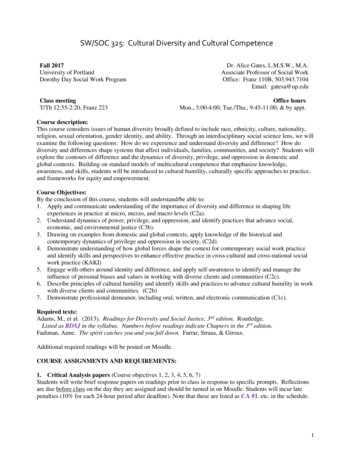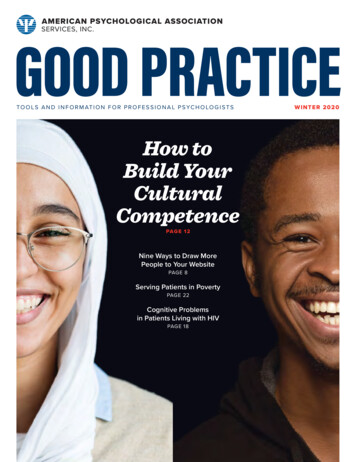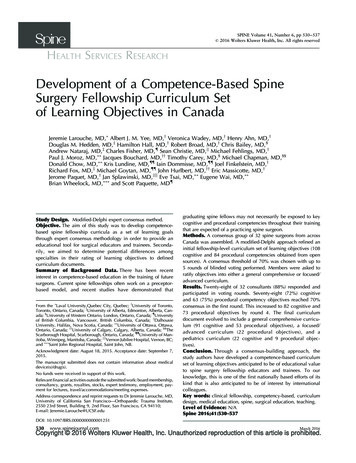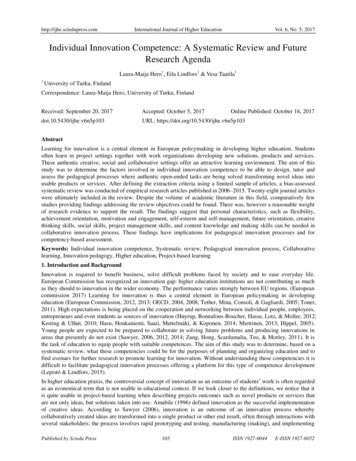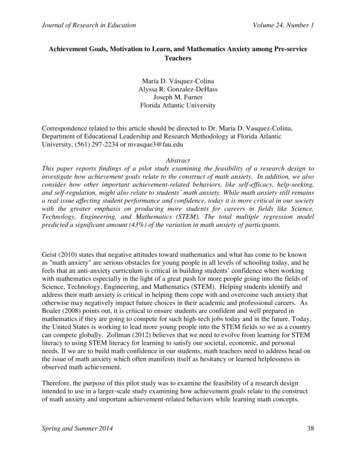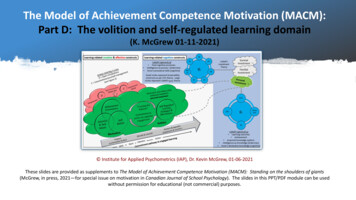
Transcription
The Model of Achievement Competence Motivation (MACM):Part D: The volition and self-regulated learning domain(K. McGrew 01-11-2021) Institute for Applied Psychometrics (IAP), Dr. Kevin McGrew, 01-06-2021These slides are provided as supplements to The Model of Achievement Competence Motivation (MACM): Standing on the shoulders of giants(McGrew, in press, 2021—for special issue on motivation in Canadian Journal of School Psychology). The slides in this PPT/PDF module can be usedwithout permission for educational (not commercial) purposes.
The Model of Achievement Competence Motivation (MACM):The volition and self-regulated learning domain(K. McGrew 01-06-2021)This is the fourth in the MACM series of on-line PPT modules. The first, the Introduction to the model isavailable oduction-of-seriesThe second, the Model Overview is available verview-of-the-modelThe third, the Motivation Domains Defined is available -motivation-domains-defined
The Model of Achievement Competence Motivation (MACM)(K. McGrew 01-06-2021)Volition(Self-Regulated Learning)
What do I need to do to succeed at this activity?How am I doing on this activity?What do I need to do differently?Possible SRL cutiveFunctionGoal SettingSelfReflectionVolition Self-Regulated LearningStrategies and PhasesSelf-EfficacyPlanning cationActionRegulationReaction &ReflectionControl &RegulationRegulatory agent-Goal levelRegulatory tion-Learning strategies-Persistence-Time management-Environmental structuring-Help seeking-Motivation-Emotion control-EffortRegulatory acy[Note. Theory circle descriptions drawn primarily from Sitzmann & Ely (2011) and supplemented by Pintrich, Wolters & Baxter (2000) and Hofmann et al. (2012).* Possible SRL components drawn from Sitzmann & Ely’s (2011) comprehensive review of self-regulation theories. Brief definitions are available at http://iapsych.com/MACM/srlfdefs.pdf]
A proposed Model of Achievement Competence Motivation (MACM): Integration of Snow’s affective (aff) and conative (con) construct domains (affcon) (McGrew, 2020)Learning-related affective constructsLearning-related conative constructsMotivation as a set of keyquestionsDo I want to do this activity?Why do I want to do this activity?What are my goals for this activity?MotivationRelative degree of influence on learning-Intrinsic Motivation-Academic Goal Orientation-Academic Motivation-Academic Goal Setting-Need for Cognition-Academic Interests-Academic ValuesTemperamentSENNA SEMS**Open-mindedness (O)-Intellectual curiosity-Creative-Imagination-Artistic interestSelf-BeliefsCan I be successful on this activity?Am I capable of doing this activity?Can I control my success on thisactivity?-Locus of Control (control)-Academic Ability Conception (control)-Academic Self-Efficacy (competence)-Academic Self-Concept (competence)Self-management esponsibility(emotionality, sociability, activitylevel, task persistence)Big 5 personalitytrait constructs-Openness (O)-Conscientiousness (C)-Neuroticism (N)-Extraversion (E)-Agreeableness (A)Volition*Self-regulated learning(SRL) strategies & phasesWhat do I need to do to succeed atthis activity?How am I doing on this activity?What do I need to do differently?More distalAchievement OrientationsInterests and Task ValuesIs this activity of interest to me?Is this activity worth the effort?More proximalPrepare-Forethought-Plan & ActivateAppraise-React & aracteristic MoodsSENNA SEMS**Negative-emotionregulation (N)-Stress modulation-Self-confidence-Frustration toleranceEngaging with others (E)-Social initiative-Assertiveness-EnthusiasmAmity (A)-Compassion-Respect-Trust-Bold font designates constructs or domains drawn or adapted from RichardSnow’s model of aptitude (Corno et al, 2002).-Wide shaded arrows represent causal relations or cyclical phase stages.*Snow model included “conative styles” under volition. This construct domain isnot included in the MACM model given the lack of robust validity researchregarding work and learning styles.** SENNA SEMS SENNA social-emotional skills measurement scale and model.
Motivation: Thing 3
Motivation: As a Set of Key Questions“What do I need to do to succeedat this activity?”“How am I doing on this activity?”“What do I need to do different?”
Conative: Self-regulation, defined as voluntary actionmanagement, seems to have become the overarchingconative concept. . volition is action control (Snow 1996)The term “volition” refers to both the strength of will needed to complete atask, and the diligence of pursuit (Corno, 1993). Kuhl (e.g., 1987) arguedthat many motivational theorists have ignored volitional processes byassuming that motivation leads directly to outcomes. He argued insteadthat motivational processes only lead to the decision to act. Once theindividual engages in action, volitional processes take over and determinewhether or not the intention is fulfilled (see also Zimmerman 1989).Eccles & Wigfield (2012)
Self – RegulatedLearningStrategies &PhasesSelf-regulated learning strategies and phases: The processes, during thepost-decisional monitoring and appraisal phases of learning, where a personactively maintains goal directed action over time (i.e., action control; strengthof will) via strategies to regulate learning and to protect learning goals inthe face of competing goals or negative affect. The regulatory processesengaged to preserve and protect the intention-action system. Processedduring the last stage of the wish-- want-- intention- action commitmentsequence (i.e., what do I need to do to succeed at this activity?; how am Idoing on this activity; what do I need to do differently?).
What do I need to do to succeed at this activity?How am I doing on this activity?What do I need to do differently?Possible SRL cutiveFunctionGoal SettingSelfReflectionVolition Self-Regulated LearningStrategies and PhasesSelf-EfficacyPlanning cationActionRegulationReaction &ReflectionControl &RegulationRegulatory agent-Goal levelRegulatory tion-Learning strategies-Persistence-Time management-Environmental structuring-Help seeking-Motivation-Emotion control-EffortRegulatory acy[Note. Theory circle descriptions drawn primarily from Sitzmann & Ely (2011) and supplemented by Pintrich, Wolters & Baxter (2000) and Hofmann et al. (2012).* Possible SRL components drawn from Sitzmann & Ely’s (2011) comprehensive review of self-regulation theories. Brief definitions are available at http://iapsych.com/MACM/srlfdefs.pdf]
Conative: Self-regulation, defined as voluntary actionmanagement, seems to have become the overarchingconative concept. . volition is action control (Snow 1996)
Relevant SRL theoreticalresearchPintrich’s FourPhase ModelHadwinSociallyShared ModelBoekaertsDualProcessingModelJarvela &Hadwin ModelWinne &Hadwin ModelEfklidesMASRL ModelZimmerman’sCyclicalPhases Model
Zimmerman’sCyclicalPhases Model
Zimmerman’sCyclicalPhases Model
Pintrich’s FourPhase Model
Boekaerts DualProcessingModel
Winne &Hadwin Model
Winne &Hadwin Model
Efklides MASRLModel
HadwinSociallyShared Model
Jarvela &Hadwin Model
SRL Models: Frequency of Publication Citations
SRL Models: Common Phases
Zimmerman’sCyclicalPhases Model
Zimmerman’sCyclicalPhases Model?
Pintrich’s FourPhase Model
Pintrich’s Four Phase SRL ModelPlanning &ActivationReaction &Reflection StrategiesMonitoringStrategiesControl & RegulationStrategiesSelf – RegulatedLearningStrategies &Phases
Pintrich’s Four Phase SRL ModelSelf – RegulatedLearningStrategies &PhasesPlanning & Activation: The metacognitive processes involved in setting initialgoals and activating prior domain-relevant knowledge and task relevantstrategies.Planningprocesses involved in selfMonitoring Strategies: The metacognitiveawareness of personal cognition and&the monitoring of various components ofone’s thinking during taskperformance.ReactionActivatio&MonitoriControl & Regulation Strategies. Thenmetacognitve processes involved inselecting and adaptingReflectiocognitiveControlstrategies tongreduce the relative discrepancybetween immediate studentStrategie performance feedback.n goals and self-generated&StrategiesRegulatiReaction & Reflection Strategies:The metacognitive processes in self-judgingsand making causal attributions to personalon performance
Pintrich’s Four Phase SRL ModelSelf – RegulatedLearningStrategies &Phases
Combined Zimmerman and Pintrich SRL ModelSelf – RegulatedLearningStrategies &Phases
Combined Zimmerman and Pintrich SRL ModelPossible SRL Components*Regulatory agents-Goal levelVolition*Self-regulated learning (SRL)strategies & phasesPrepare-Forethought-Plan & eact & Reflect-Evaluate* From Sitzmann & Ely (2011)Regulatory tional control-Learning strategies-Persistence-Time management-Environmental structuring-Help seeking-Motivation-Emotion control-EffortRegulatory acy
SRL mechanisms suggested by Sitzmann & Ely’s (2011)Possible SRL Components*comprehensiveresearch synthesisRegulatory agents-Goal levelRegulatory tional control-Learning strategies-Persistence-Time management-Environmental structuring-Help seeking-Motivation-Emotion control-EffortRegulatory acy
SRL mechanisms suggested by Sitzmann & Ely’s (2011)comprehensive research synthesis
SRL mechanisms suggested by Sitzmann & Ely’s (2011)comprehensive research synthesisRegulatory agents:“Regulatory agents are instrumental for initiating selfregulated learning. Goals are regulatory agents .Goalsreflect the standard for successfully accomplishing a task,and self-regulation theories agree that goals provide acriterion for monitoring, evaluating, and guiding selfregulatory activity” (p. 423) Goal level: Setting an initial standard for the successfulaccomplishment of goals.
Regulatory mechanisms“Regulatory mechanisms are the crux of self-regulated learning because they are largely under thecontrol of trainees and have an instrumental role in determining whether trainees make progresstoward their goals in an efficient and organized manner. Furthermore, the majority of these constructshave been subjected to extensive empirical investigations” (p. 424). Planning: Thinking through, often at a formative or preliminary level, what needs to learned and thespecific steps or strategies needed to reach learning goals. Monitoring: Paying attention to one’s performance, including feedback of what is being learned, thatleads to changes in strategies, affect or behavior. Metacognition: Depending on theory, a construct that subsumes all, or just a handful of, selfregulation constructs Attentional control: The ability to maintain cognitive focus, concentration, and attention duringlearning. The ability to divide cognitive resources between on- and off-task relevant and irrelevantinformation.
Learning strategies: Includes a variety of strategies for enhancing learning such as elaboration,integrating new knowledge into existing stores of acquired knowledge, breaking tasks intosmaller subtasks, reorganization, etc. Persistence: The ability to maintain effort and concentration during learning despite boredom,frustration, or failure. Time management: Allocating, monitoring, or scheduling time to different tasks during learningactivities. Environmental structuring: Selecting or designing a location or environment conducive tolearning (e.g., free from distractions). Monitoring and modifying the environment as needed. Help seeking: Seeking assistance when experiencing difficulty during learning. Knowing when,why, and whom to approach for help. Motivation: Willingness to engage in learning based on a person’s beliefs about the incentives orvalue for learning a task.
Emotion control: Monitoring and controlling the intrusion of negative affective states (e.g., anxiety,frustration) which impact attentional control, during task performance, via engagement in appropriatestrategies (e.g., relaxation exercises, self-encouragement, and self-talk, etc.). Effort: Self-control of the amount of effort and concentration to devote to learning based on self-monitoring(feedback) during performance, particularly when detecting a goal-performance discrepancy.Regulatory appraisals“Regulatory appraisals are instrumental in assessing goal progress as well as determining whether trainees willeither begin or continue striving to make progress toward their goals. A scarcity of empirical evidence existsregarding the role of two regulatory appraisal constructs—self-evaluation and attributions—in self-regulatedlearning, but extensive research has focused on the third regulatory appraisal: self-efficacy. Self-evaluation: Evaluating one’s progress during learning via the comparison of current learning efficiency orsuccess and final desired goal state. Attributions: The process of attributing causation (e.g., ability, effort) to failure or success in attaining thedesired goal outcome. Self-efficacy: Appraisal or evaluation, during or after performance, that contributes to an individual’sconfidence in the ability to solve problems or accomplish tasks.
SRL:PrepatoryPhaseThe metacognitive processesinvolved in setting initial goalsand activating prior domainrelevant knowledge and taskrelevant strategies.
SRLPlanning &ActivationEffective self-regulated students use forethought when approachinga task in order to develop a plan and to activate relevant priorknowledge necessary for successful task performance.Planning and activation is defined as the processes of: (a) settinginitial task specific goals (goal setting); (b) activating (oftenautomatically without conscious thought) prior relevant knowledgein the relevant task domain; and (c) activating task relevantmetacognitive strategies (e.g., rehearsal, elaboration, comprehensionmonitoring) (Pintrich, 2000b; Pintrich & Zusho, 2002).(McGrew et al., 2004)
SRLPerformancePhaseThe metacognitive processes involved in self-awareness ofpersonal cognition and the monitoring of various components ofone’s thinking during task performance. The activation ofstrategies for selecting, adapting, and changing cognitive strategiesto reduce the relative discrepancy between immediate goals andself-generated performance feedback judgments. (The list ofpossible control strategies is relatively large and represents themost researched component of SRL--see table footnote.)(McGrew et al., 2004)
SRLControl &RegulationStrategiesSRL control and regulation activities are defined as the activation ofmetacognitive strategies for selecting, adapting, and changing cognitivestrategies to reduce the relative discrepancy between immediate studentgoals and self-generated performance feedback judgments (Pintrich, 2002a).The list of possible control strategies is relatively large and represents themost researched component of SRL. Example control and regulationstrategies include paraphrasing, outlining, summarizing, rehearsal, questiongenerating, visualizing (imagery), drawing of cognitive or semantic maps, notetaking, and using mnemonic devices to name but a few.(McGrew et al., 2004)
SRLAppraisalPhaseThe metacognitive processes inself-judging and making causalattributions to personalperformance.
SRLReaction &ReflectionStrategiesThe final SRL phase involves a student evaluating and judging theirperformance and making causal attributions for their performance. Studentswho do not self-evaluate their performance or who are not cognizant of theimportance of self-evaluation, tend to engage in surface (vs deep) processing inlearning and also tend to display more negative affect and lower effort(Pintrich, 2002). Taking time to reflect on one's learning and learning processesis associated with more successful academic outcomes. Stated briefly, SRLreaction and reflection strategies are defined as a student's self-judging theirperformance and making causal attributions for their performance.(McGrew et al., 2004)
SRLMonitoringStrategiesDrawing largely on the research of Nelson and Narens (1990), a variety of metacognitive judgments havebeen postulated to occur during performance monitoring (Pintrich, 2000a; Winne & Jamieson-Noel,2002). According to Pintrich (2000b), judgments of learning (JOLs) encompasses a variety of monitoringactivities such as the student: (a) becoming aware that they are not comprehending what they have justread or heard; (b) becoming aware they are reading or studying too quickly or slowly; (c) engaging inself-questioning to self-check understanding; and (d) performing a self-memory test on material tocheck on readiness for an exam, etc. Feelings (judgments) of knowing (FOK) describe the metacognitiveprocess of the student assigning a probability to the “information that is believed to be stored inmemory but that the learner cannot recall at the moment” (Winne & Jamieson-Noel, 2002, p. 552) .InSRL, monitoring includes the metacognitive components of being aware of one's personal cognition andthe monitoring of various aspects of one's cognition during task performance (Pintrich, 2000b).(McGrew et al., 2004)
SRLMonitoringStrategies
SRLMonitoringStrategies
SelfRegulatedLearning
Self –RegulatedLearningGood resource
SRL: New, emerging or relatedresearch and theory: Interestself-regulationSelf –RegulatedLearning
SRL: New, emerging or relatedresearch and theorySelf –RegulatedLearning
SRL: New, emerging or related research and theorySelf –RegulatedLearning
SRL: New, emerging or related research and theorySelf –RegulatedLearning
Strategies & Phases Self-regulated learning strategies and phases: The processes, during the post-decisional monitoring and appraisal phases of learning, where a person actively maintains goal directed action over time (i.e., action control; strength of will) via strategies
